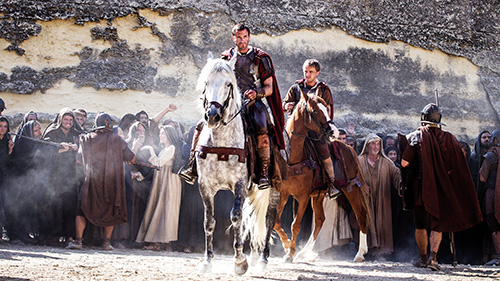
Joseph Fiennes and Tom Felton star in a scene from the movie “Risen.” The Catholic News Service classification is A-III – adults. The Motion Picture Association of America rating is PG-13 – parents strongly cautioned. Some material may be inappropriate for children under 13. (CNS photo/Columbia Pictures)
By Bishop Robert Barron
When I saw the coming attractions for the new film Risen – which deals with a Roman tribune searching for the body of Jesus after reports of the resurrection – I thought that it would leave the audience in suspense, intrigued but unsure whether these reports were justified or not. I was surprised and delighted to discover that the movie is, in fact, robustly Christian and substantially faithful to the Biblical account of what transpired after the death of Jesus.
My favorite scene shows tribune Clavius (played by the always convincing Joseph Fiennes) bursting into the Upper Room, intent upon arresting Jesus’ most intimate followers. As he takes in the people in the room, he spies Jesus, at whose crucifixion he had presided and whose face in death he had closely examined. But was he seeing straight? Was this even possible? He slinks down to the ground, fascinated, incredulous, wondering, anguished.
As I watched the scene unfold, the camera sweeping across the various faces, I was as puzzled as Clavius: was that really Jesus? It must indeed have been like that for the first witnesses of the Risen One, their confusion and disorientation hinted at in the Scriptures themselves: “They worshipped, but some doubted.” Once Thomas enters the room, embraces his Lord and probes Jesus’ wounds, all doubt, both for Clavius and for the viewer, appropriately enough, is removed.
I especially appreciated this scene, not only because of its clever composition, but because it reminded me of debates that were fashionable in theological circles when I was doing my studies in the 1970’s and 1980’s. Scholars who were skeptical of the bodily facticity of Jesus’ resurrection would pose the question, “What would someone outside of the circle of Jesus’ disciples have seen had he been present at the tomb on Easter morning or in the Upper Room on Easter evening?” The implied answer to the query was “well, nothing.”
The academics posing the question were suggesting that what the Bible calls resurrection designated nothing that took place in the real world, nothing that an objective observer would notice or dispassionate historian recount, but rather an event within the subjectivity of those who remembered the Lord and loved him.
For example, the extremely influential and widely-read Belgian theologian Edward Schillebeeckx opined that, after the death of Jesus, his disciples, reeling in guilt from their cowardice and betrayal of their master, nevertheless felt forgiven by the Lord. This convinced them that, in some sense, he was still alive, and to express this intuition they told evocative stories about the empty tomb and post-resurrection appearances of Jesus.
Roger Haight, a Jesuit theologian of considerable influence, speculated in a similar vein that the resurrection is but a symbolic expression of the disciples’ conviction that Jesus continues to live in the sphere of God. Therefore, Haight taught, belief in the empty tomb or the appearances of the risen Lord is inessential to true resurrection faith.
At a more popular level, James Carroll explained the resurrection as follows: after their master’s death, the disciples sat in a kind of “memory circle” and realized how much Jesus meant to them and how powerful his teaching was and decided that his spirit lives on in them.
The great English Biblical scholar N.T. Wright is particularly good at exposing and de-bunking such nonsense. His principal objection to this sort of speculation is that it is profoundly non-Jewish. When a first century Jew spoke of resurrection, he could not have meant some non-bodily state of affairs. Jews simply didn’t think in the dualist categories dear to Greeks and later to Gnostics. The second problem is that this post-conciliar theologizing is dramatically unhistorical.
Wright argues that, simply on historical grounds, it is practically impossible to explain the rise of the early Christian movement apart from a very objective construal of Jesus’ resurrection from the dead. For a first-century Jew, the clearest possible indication that someone was not the promised Messiah would be his death at the hands of Israel’s enemies, for the unambiguously clear expectation was that the Messiah would conquer and finally deal with the enemies of the nation.
Peter, Paul, James, Andrew, and the rest could have coherently proclaimed – and gone to their deaths defending – a crucified Messiah if and only if he had risen from the dead. Can we really imagine Paul tearing into Athens or Corinth or Ephesus with the breathless message that he found a dead man deeply inspiring or that he and the other Apostles had felt forgiven by a crucified criminal? In the context of that time and place, no one would have taken him seriously.
Risen’s far more reasonable and theologically compelling answer is that, yes indeed, if an outsider and unbeliever burst into the Upper Room when the disciples were experiencing the resurrected Jesus, he would have seen something along with them. Would he have fully grasped what he was seeing? Obviously not. But would the experience have had no objective referent? Just as obviously not. There is just something tidy, bland, and unthreatening about the subjectivizing interpretations I rehearsed above.
What you sense on every page of the New Testament is that something happened to the first Christians, something so strange and unexpected and compelling that they wanted to tell the whole world about it. Frankly, Risen conveys the edgy novelty, the unnerving reality of the resurrection, better than much contemporary theologizing.
(Bishop Robert Barron is an auxiliary bishop of the Archdiocese of Los Angeles and the founder of Word on Fire Catholic Ministries.)
